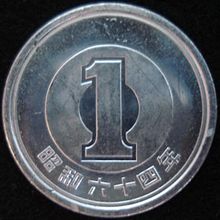1 yen coin
| Japan | |
| Value | 1 Japanese yen |
|---|---|
| Mass | 1 g |
| Diameter | 20 mm |
| Thickness | 1.5 mm |
| Edge | Smooth |
| Composition | 100% Al |
| Years of minting | 1955–present |
| Obverse | |
 |
|
| Design | Young tree with the words "State of Japan" above, and "1 Yen" below. |
| Design date | 1955 |
| Reverse | |
 |
|
| Design | "1" in a circle with year of issue in kanji- (Showa Period year 64- 1989) |
| Design date | 1955 |
The 1 yen coin (一円硬貨 Ichi-en kōka?) is the smallest denomination of the Japanese yen currency. The first Japanese one yen coin was minted in 1871, and was made out of silver. Eventually gold coins were also produced causing co-circulation among the two. Silver one yen coins ceased production in 1914. Brass one yen coins were made in the late 1940s, but the current design was first minted in 1955. The current design is made up of an aluminium alloy which has remained unchanged since the coin was first minted. In the early 2010s increasing usage of electronic money led to a lack of demand, and production of the coin was confined to mint sets until 2014. Like the U.S. penny, the Japanese mint has suffered losses due to a rising cost of the base metal it takes to produce the coins.
The one yen coin is the oldest modern denomination coin, the design has remained the same since its introduction in 1955. The obverse of the coin has a figure "1" in a circle that represents one yen, below the digit is the year of issue which is written in kanji. The reverse side has a young tree, intended to symbolize the healthy growth of Japan.
The first Japanese one yen coin was minted in 1870, at first these coins were primarily minted in silver. The obverse of these coins featured a dragon with a circular inscription around it. The reverse had a radiant sun surrounded by a wreath, with the chrysanthemum emblem (a symbol of the Japanese Imperial Family) flanked by two seals of the Japanese government. The following year though Japan switched to the Gold standard in order to keep up with countries in North America, and Europe. Production of silver one yen coins was halted, and new small gold coins took their place. Through 1874-1875, one-yen silver coins were again minted with a new design only to be halted again sometime in 1875 in favor of "Trade Dollars". Both silver and gold coins co-circulated after 1878 when Japan went with a bimetallic standard, and production again resumed of silver one yen coins. Gold one yen coins were minted until 1880, while the silver ones lasted until 1914.
...
Wikipedia
